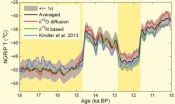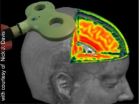(Press-News.org) Munich, Germany: An electronic nose can be used to successfully detect different sub-groups of asthmatic children, according to a new study.
The new research, presented at the European Respiratory Society (ERS) International Congress in Munich today (7 September 2014), is part of the U-BIOPRED* project to learn more about different types of asthma to ensure better diagnosis and treatment for each person.
Healthcare professionals now understand that there are many different types of asthma and that it affects people in very different ways. Current research efforts are focused on categorising these different clusters into phenotypes and on revealing underlying pathophysiological pathways of these smaller sub groups of asthma. If this can be achieved, it will help healthcare professionals tailor asthma treatment to suit each person, rather than a 'one size fits all' approach.
The new study analysed the profile of exhaled breath in samples from 106 children with asthma or wheeze. This involved looking at particles in the breath known as exhaled volatile compounds, which are then analysed by so-called electronic noses.
The results showed five distinct sub-groups. Each cluster contained patients with similar breath profiles. When comparing the clinical characteristics of these groups they differed in age and asthma symptoms. The findings suggest that exhaled-breath analysis by an electronic nose can be useful in understanding the differences between individuals with asthma, which could ultimately help with identifying sub-groups of the condition.
Paul Brinkman, lead author of the study from the Academic Medical Centre in Amsterdam, said: "We know electronic noses have the potential to help us understand more about a range of lung diseases. In this study, we have shown that they are an effective method of understanding more about the subtle differences seen between people with asthma. By classifying asthma into different subgroups, we might be able to provide much more tailored treatment for each individual."
INFORMATION:
* Unbiased biomarkers in prediction of respiratory disease outcomes (U-BIOPRED)
Electronic nose can detect sub-groups of asthma in children
2014-09-07
ELSE PRESS RELEASES FROM THIS DATE:
Timing of food intake could impact the effectiveness of TB treatment
2014-09-07
Munich, Germany: The timing of food intake in the early phase of TB treatment could have a negative impact on the effectiveness of TB treatment.
A new study, presented at the European Respiratory Society (ERS) International Congress in Munich today (07 September 2014), suggests that eating food just before taking a TB drug could reduce the effectiveness of the medicine.
Researchers conducted a small study looking at 20 patients who were about to begin treatment for TB for the first time. They were given the usual course of TB drugs, including isoniazid, rifampicin, ...
Patients call for health professionals to discuss care needs in life-threatening illnesses
2014-09-07
Munich, Germany: Patients with COPD would like healthcare professionals to discuss palliative care needs in more detail, according to a new study.
Palliative care refers to care that is focused on making a person comfortable and relieving symptoms, rather than treating a condition. It is often connected with end-of-life care; although it can refer to any stage of care for any life-threatening condition.
The research, presented at the European Respiratory Society (ERS) International Congress in Munich today (7 September 2014), investigated the preferences of patients ...
Mandatory policy boosts flu vaccination rates among health care workers
2014-09-07
DETROIT – Hospitals can greatly improve their flu vaccination rate among health care workers by using a mandatory employee vaccination policy, according to a Henry Ford Health System study.
Citing its own data, Henry Ford researchers say the health system achieved employee vaccination rates of 99 percent in the first two years of its mandatory policy, in which annual vaccination compliance is a condition of employment.
Nationally, 63 percent of health care workers were immunized against the flu in the past two years, according to the Centers for Disease Control and ...
New single-dose influenza drug appears safe and effective
2014-09-06
An analysis of phase 2 and phase 3 clinical trials shows that a single injected dose of the neuraminidase inhibitor (NAI) peramivir is safe and effective at alleviating influenza symptoms, including fever and viral shedding, when administered within 48 hours of the onset of symptoms. Researchers report their findings today at the 54th Interscience Conference on Antimicrobial Agents and Chemotherapy (ICAAC), an infectious diseases meeting of the American Society for Microbiology (ASM).
"Based on clinical data, peramivir is the first neuraminidase inhibitor (NAI) that ...
Antibiotic stewardship programs reduce costs, improve outcomes
2014-09-06
Antibiotic stewardship programs, which promote the appropriate use of antibiotics in hospitals and other healthcare centers, not only lead to reduction in antibiotic use with reduced adverse events, but also lead to significant savings. In the case of one New York hospital, more than $600,000 was saved annually, according to research presented today at the 54th Interscience Conference on Antimicrobial Agents and Chemotherapy (ICAAC), an infectious diseases meeting of the American Society for Microbiology (ASM).
"This work emphasizes the rational approach to treating patients: ...
New study reveals strong link between higher levels of pollution and lung health of European citizen
2014-09-06
New data has identified a clear link between higher levels of exposure to air pollution and deteriorating lung health in adult European citizens. This study confirms previous findings that children growing up in areas with higher levels of pollution will have lower levels of lung function and a higher risk of developing symptoms such as cough and bronchitis symptoms. Additionally, the new study identified that people suffering from obesity are particularly vulnerable to the negative effects of air pollution, possibly due to an increased risk of lung inflammation.
Senior ...
Penn team finds ovarian cancer oncogene in 'junk DNA'
2014-09-06
PHILADELPHIA - Over the years researchers have made tremendous strides in the understanding and treatment of cancer by searching genomes for links between genetic alterations and disease.
Most of those studies have focused on the portion of the human genome that encodes protein – a fraction that accounts for just 2 percent of human DNA overall. Yet the vast majority of genomic alterations associated with cancer lie outside protein-coding genes, in what traditionally has been derided as "junk DNA." Researchers today know that "junk DNA" is anything but – much of it is ...
Past temperature in Greenland adjusted
2014-09-05
One of the common perceptions about the climate is that the amount of carbon dioxide in the atmosphere, solar radiation and temperature follow each other – the more solar radiation and the more carbon dioxide, the hotter the temperature. This correlation is also seen in the Greenland ice cores that are drilled through the approximately three kilometer thick ice sheet. But during a period of several thousand years up until the last ice age ended approximately 12,000 years ago, this pattern did not fit and this was a mystery to researchers. Now researchers from the Niels ...
WHO-commissioned report on e-cigarettes misleading, say experts
2014-09-05
World leading tobacco experts argue that a recently published World Health Organization (WHO)-commissioned review of evidence on e-cigarettes contains important errors, misinterpretations and misrepresentations putting policy-makers and the public in danger of foregoing the potential public health benefits of e-cigarettes.
The authors, writing today in the journal Addiction, analyse the WHO-commissioned Background Paper on E-cigarettes, which looks to have been influential in the recently published WHO report calling for greater regulation of e-cigarettes.
Professor ...
Visualizing plastic changes to the brain
2014-09-05
Tinnitus, migraine, epilepsy, depression, schizophrenia, Alzheimer's: all these are examples of diseases with neurological causes, the treatment and study of which is more and more frequently being carried out by means of magnetic stimulation of the brain. However, the method's precise mechanisms of action have not, as yet, been fully understood. The work group headed by PD Dr Dirk Jancke from the Institut für Neuroinformatik was the first to succeed in illustrating the neuronal effects of this treatment method with high-res images.
Painless Therapy
Transcranial magnetic ...



